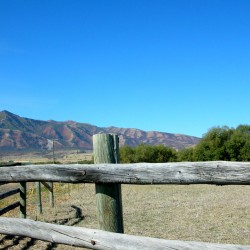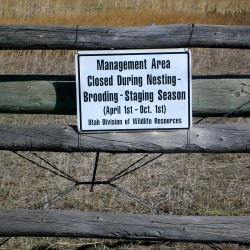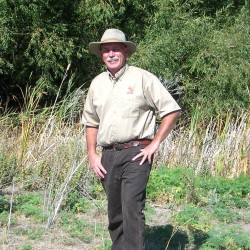Bud Phelps WMA: Haven for birds, treasure for nature lovers
October 2nd, 2010 Posted in Arts and LifeStory and photos by Storee Powell
MENDON–The 150-acre Bud Phelps Wildlife Management Area, situated between the Mount Naomi Wilderness on the east and Wellsville Mountains on the west, is what the Bridgerland Audubon Society president describes as “a birder’s paradise.”
C. Val Grant is the president of the local chapter of the National Audubon Society. The bird-watcher and conservation group is a patron of the Bud Phelps Wildlife Management Area (BPWMA).
 “This area is a great place to go birding because it is so calm,” Grant said. “The birds don’t scatter too easy, jumping when they see a human in the distance because it is such a protected place. We just love that area.”
“This area is a great place to go birding because it is so calm,” Grant said. “The birds don’t scatter too easy, jumping when they see a human in the distance because it is such a protected place. We just love that area.”
It is located along 600 South in Logan, just before Mendon’s city boundary. The area is named for John E. “Bud” Phelps, a director of the Utah Division of Wildlife Resources (UDWR) during the 1960s and ’70s. Phelps was a winner of the Seth Gordon Award in 1980, the Association of Fish and Wildlife Agencies’ highest honor, according to www.fishwildlife.org. The award is given to those “who have worked steadfastly and effectively for the best use of North American natural resources in the public trust and for contributions to the programs of the Association.”
Phil Douglass is the northern region conservation outreach manager for UDWR. He said the Bud Phelps WMA’s habitat is a marsh land featuring wildlife such as small mammals like meadow voles (a field mouse) and a great variety of waterfowl. Birds include the song sparrow, northern harrier (marsh hawk), common yellowthroat, sandhill crane, willow flycatcher, eastern kingbird, tree sparrow and short-eared owl.
Douglass said the area has tree-nesting birds and water birds. The cattails provide ground nesting for marsh wrens and red-winged blackbirds. The marshes give waterfowl like mallard ducks and cinnamon teal a home. The area is used as a migratory stop for some birds, like yellow warblers. In the fall, raptors move into the area because they like to take advantage of the small mammals.
Birding is not the only purpose of the Bud Phelps WMA, which is managed by the Utah Division of Wildlife Resources. “The area is built for wildlife and those who love wildlife, so you have to keep those two purposes in mind, and sometimes one excludes the other,” he said.
 This means the public can’t use the area when wildlife needs it the most. Bud Phelps WMA is closed to the public from April 1 to Oct. 1 for the nesting and staging season of many birds, in order to protect the wildlife.
This means the public can’t use the area when wildlife needs it the most. Bud Phelps WMA is closed to the public from April 1 to Oct. 1 for the nesting and staging season of many birds, in order to protect the wildlife.
“It is closed some times of the year to provide the best benefit to the critters, however, when it is not closed, it is open for recreation. I encourage people to enjoy this area by canoe or kayak,” Douglass said. “Rocky Mountain Power owns the Cutler Reservoir, and they have also espoused the wildlife recreation values of this area. And so they have created boat ramps and water trails for people to enjoy.”
Cutler Reservoir is adjacent to the Bud Phelps WMA, and is 1,000 acres. David Eskelsen, a manager of external communications for Rocky Mountain Power, said the company is works closely with the area to help provide reasonable access to the public for recreation, including providing boat ramps. The ramps are located on the Logan and Bear Rivers, and connect to the wetland marshes of the Bud Phelps.
The three boat ramps, Douglass said, are the Valley View boat ramp,  the Benson Marina boat ramp and the Cutler Canyon boat launch. Users of motorboats should know these areas are designated for wakeless speed. A table of these access points and other resources is available at http://www.pacificorp.com/about/or/utah.html.
the Benson Marina boat ramp and the Cutler Canyon boat launch. Users of motorboats should know these areas are designated for wakeless speed. A table of these access points and other resources is available at http://www.pacificorp.com/about/or/utah.html.
Hunting is also allowed at the area, which offers many upland game birds such as pheasants and waterfowl. Douglass said such areas are acquired or improved as a result of hunters’ dollars. When hunters buy licenses and hunting equipment with special taxes, the funds go directly back to benefit wildlife.
Douglass said it should be noted that the area was originally purchased to function as a buffer for the surrounding marsh area.
“The thing that makes wetlands functioning and the most valuable is when they have good upland buffers to protect them from human activities, from encroachment onto these other areas,” Douglass said.
There are some things recreationists should do to prepare before going to the area.
“Wear mosquito repellent and sun protection, and bring binoculars,” said Bridgerland Audubon president Val Grant.
Douglass said another word of caution is, “Getting stuck in the mud during winter is a real possibility, so it is never good to go alone.”
Another tip from Douglass is to read Access to Wildlife Lands in Utah, a publication by the UDWR. The publication details the purpose of the land, the lay of the land and what activities are allowable during different seasons. The publication can be accessed at www.wildlife.utah.gov/publications.
Also, users of the area should know, according to a sign posted on the entrance, the area is closed to dog training.
“The take-home message is to get out and enjoy these treasures, these wildlife values are what makes living in Utah neat,” Douglass said. How fortunate are the people of Cache Valley to have so much wildlife close to them.”
To see photos of the area, including its wildlife, go to utahwildlifephotos.com and search “Phil Douglass.”
A note from the Bridgerland Audubon Society :
Bud Phelps Wildlife Management Area Entrance
“About three miles west of Logan on the Mendon Road (600 South from Logan, at 3600 West), look for a small Utah Division of Wildlife Resources’ sign marked “Bud Phelps Wildlife Management Area East Entrance.” Turn north and after a half mile turn west down a dirt road (look for black metal posts on either side of the road) to a small parking area marked as part of the Bud Phelps Wildlife Management Area. From here, you can access PacifiCorp’s property by walking westward on the dirt road. At the end of the road, there is a corral area with gates to the south and west. Go through the west gate and feel free to wander west or north to explore the wetlands. There are no marked trails, but you can observe songbirds, Short-eared owls and other wildlife, including small mammals. In winter, look for tracks of small mammals and puzzle out their wanderings. Please close any gates you might open in respect of historic grazing uses of the land.”
NW
Tags: birding, Bud Phelps, Mendon, wildlife management area

One Response to “Bud Phelps WMA: Haven for birds, treasure for nature lovers”
By Lee on Oct 13, 2010
I have pass may years but nave hunt it this blog has a good point never go out alone in boat if you get stuck you have someone to help you these wildlife mentioned are good for the waterfowl for places to hunt or birdwatching marshes are a very beautiful place and should be enjoyed by all http://waterfowlhuntingtips.blogspot.com/